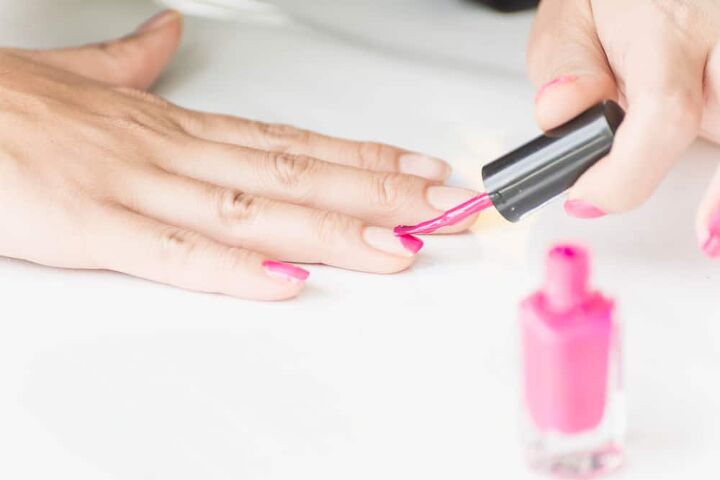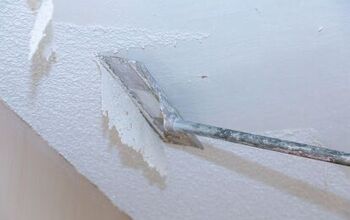How To Get Nail Polish Off Walls Without Removing Paint

Painting your nails is one of those things that rarely gets out of hand, but once in a while, polish spills. When it does, most of us pray that it doesn’t get on walls. If it does, well, it’s normal to be at a loss. A little polish might be easy to wipe away if it’s clear, but when it’s pigmented, you might have a hard time cleaning things up. So how can you do this without wrecking your wall paint?
The best way to get nail polish off walls is to scrape it off with a razor blade if it’s dried on, or to wipe it away with a wet wipe if it’s a new mess. Anecdotally, some people claim spraying WD-40 can help remove still-damp nail polish off walls. Most other options, however, are going to run the risk of removing paint regardless of how careful you are.
Nail polish, in and of itself, is going to pose a hard time for anyone who has to clean it up. This guide will make it easier for you.
Do You Need to Hire a Paint Contractor?
Get free, zero-commitment quotes from pro contractors near you.

How Bad Is A Nail Polish Stain On Your Wall?
We’re not going to mince words. It’s pretty bad. Like, it’s harder to get nail polish off your walls than it is to get other types of makeup off your carpet or walls. Nail polish is tough, especially when you’re removing it off another painted surface. If you cannot scrape it off or wipe it away with a cleansing cloth, your options are limited.
Should You Let The Nail Polish Dry?
If your nail polish is still wet, you should not wait until it’s dry to remove it. Your best chance of successfully trying to get the stain off your wall is to attend to it as soon as you see the paint hit the wall. Since time is an issue, you may need to work fast in order to get the best possible results.
Remove Nail Polish Off Your Walls: How To Do It
Since we’ve already discussed the safest methods, it’s important to emphasize that most methods will run the risk of having some small bits of paint get removed as well. With that said, these options are the best potential methods to do it.
Nail Polish Remover
Nail polish’s biggest enemy is nail polish remover, and that’s by design. Unsurprisingly, using nail polish remover will remove nail polish from just about anything. To use this method with minimal damage to your walls, do the following:
- Get a Q-tip and dip it in nail polish remover. Let it soak in.
- Use the Q-tip to dab at the stain, letting the remover pick up most of the paint. If you need to, switch cotton swabs midway.
- Once you have most of the stain gone, use a wet cloth to soak up anything else. Dry with a paper towel.
Rubbing Alcohol
Along with being able to remove dry erase marker off of just about anything, rubbing alcohol can prove to be a fair ally in the fight against nail polish too. Using rubbing alcohol is fairly easy to do. The best way to make sure that you minimize risk is to use the same procedure as with nail polish remover.
WD-40
WD-4o is a method we mentioned as a safe option, but there is a caveat here. The oil in this lubricant can cause minor stains in light walls if they aren’t sealed. It’s also worth mentioning that WD-40 will only work if the nail polish in question is still damp and freshly thrown on your wall.
To use WD-40, just spray some of it on liberally and wipe it off with a rag. This option doesn’t always work, but it’s worth a try. You never know what will make that nail polish varnish.
Soap And Water
Soap and water are generally assumed to be safe for most wall paints, especially if you’re talking about a high gloss paint coating. However, it’s not going to be a typical “tablespoon in a gallon” mix used for most other household cleaning projects. To get a mixture that’s both safe and effective for nail polish removal, blend one part dish soap with two parts water.
Use this mixture as a way to blot the majority of the nail polish stain away. Once it’s mostly gone, use it to wipe down the rest of the area. You should expect minimal to no staining from this method, as long as you do it while the stain is still wet.
Mr. Clean’s Magic Eraser
Oh, what doesn’t this petite cleaning tool do? The Magic Eraser is known for being able to pick up virtually any stain, and that includes nail polish stains. However, this is a pretty tricky issue. There have been some anecdotal reports of certain paint colors getting damaged as a result of using a Magic Eraser.
If you want to use this option, make sure to do a test patch elsewhere. This way, you can tell whether or not your walls can handle the Eraser. If a nondescript corner of your wall can handle a gentle scrubbing with a Magic Eraser, chances are that you can use it to get rid of nail polish stains, too.
Borax
Borax powder is one of the safest ways to get rid of hard stains on painted walls, though it’s a terrible choice for wallpaper. If you want to get nail polish off using borax, it’s easy to do. Here’s how:
- Mix a teaspoon of ammonia, an ounce of borax, and a liter of water. Stir well.
- Use a rag dipped in this solution to scrub at the stain. Some actually go so far as to let it soak in for 10 minutes or so.
- Dab at the stain and keep scrubbing until it’s gone. Once it’s gone, wipe the area down with water and pat it dry.
What Should You Do If The Paint Is Damaged?
Let’s say you tried to clean your walls, only to see that the paint is seriously damaged. There’s a smudge, a smear, and you need to fix things ASAP. Sadly, if you get the paint damaged, then your options are somewhat limited. In most cases, you can usually do one of two things:
- You can paint over the stain to match the original color of the wall. This is the best option. You will need to get a paint can that has a similar (ideally identical) shade and some primer. If you can get self-priming paint, then it turns into a one-step deal.
- Or, you can try to paint over the stain with a nail polish that matches the wall. This usually works best with white nail polish, ideally with the same finish. Because of the potential damage it can do to your wall, we don’t suggest it unless you have to fix it ASAP.
Of course, if the issue at hand deals with a potentially angry landlord, your best bet is to come clean to the landlord and ask if he wants you to repair it. If he’s open to spending the money to fix it or has a contract with a maintenance crew, then you might be able to avoid a repair fee of your own.
Do You Need to Hire a Paint Contractor?
Get free, zero-commitment quotes from pro contractors near you.

Related Questions
Can you use acetone on painted walls?
You can, but it’s rarely ever a good idea. Acetone has the pesky habit of dissolving latex paint, which means that it can cause serious damage to latex-based paints on your wall. If you have a different type of paint, you might not get wall damage that’s as noticeable. Even so, most people should never put acetone anywhere near their painted walls. It’s just too much of a risk.
Can vinegar damage painted walls?
Most walls that are coated with latex paint can’t handle harsh cleaners like bleach, rubbing alcohol, or paint thinner. Thankfully, diluted vinegar is one of a handful of choices you can use that most walls can handle. If you have a wall stain you want to get rid of, using vinegar as a cleaning agent on your walls is a good choice.Sadly, if you cannot remove the stain using vinegar, borax, or soapy water, you may have to repaint your walls. Vinegar is about as harsh as latex-based paints can tolerate without turning into a dissolved mess. With that said, you still have to dilute vinegar if you want to use it on walls. Regular strength vinegar is still too harsh for paint.
Will rubbing alcohol damage car paint?
Rubbing alcohol is one of the worst things that you can put on a newly-painted car. When left at full strength, rubbing alcohol can eat away at the shine of a new coat of paint fairly quickly. However, if you dilute it, things might be a bit different.Diluted rubbing alcohol is regularly used to prep other surfaces for other coatings. It’s often used for glass, mirrors, and even car tires prior to a treatment. It’s a good cleaning agent, which is why it still is popular in garages.

Ossiana Tepfenhart is an expert writer, focusing on interior design and general home tips. Writing is her life, and it's what she does best. Her interests include art and real estate investments.
More by Ossiana Tepfenhart













![The 10 Best Table Saws - [2022 Reviews & Buyer's Guide]](https://cdn-fastly.upgradedhome.com/media/2023/07/31/9070645/the-10-best-table-saws-2022-reviews-buyer-s-guide.jpg?size=350x220)
![How Much Weight Can a 4×4 Support Horizontally? [It Depends!]](https://cdn-fastly.upgradedhome.com/media/2023/07/31/9070333/how-much-weight-can-a-44-support-horizontally-it-depends.jpg?size=350x220)









![12 Washing Machine Brands to Avoid [with Recall Data]](https://cdn-fastly.upgradedhome.com/media/2023/07/31/9075781/12-washing-machine-brands-to-avoid-with-recall-data.jpg?size=350x220)


